Crispy deep-fried tofu served in a flavorful umami sauce, Agedashi Tofu is a popular appetizer you can find at izakaya and Japanese restaurants. It requires deep-frying, but the process is easier than you think. Skip the bonito flakes to make it vegan-friendly!
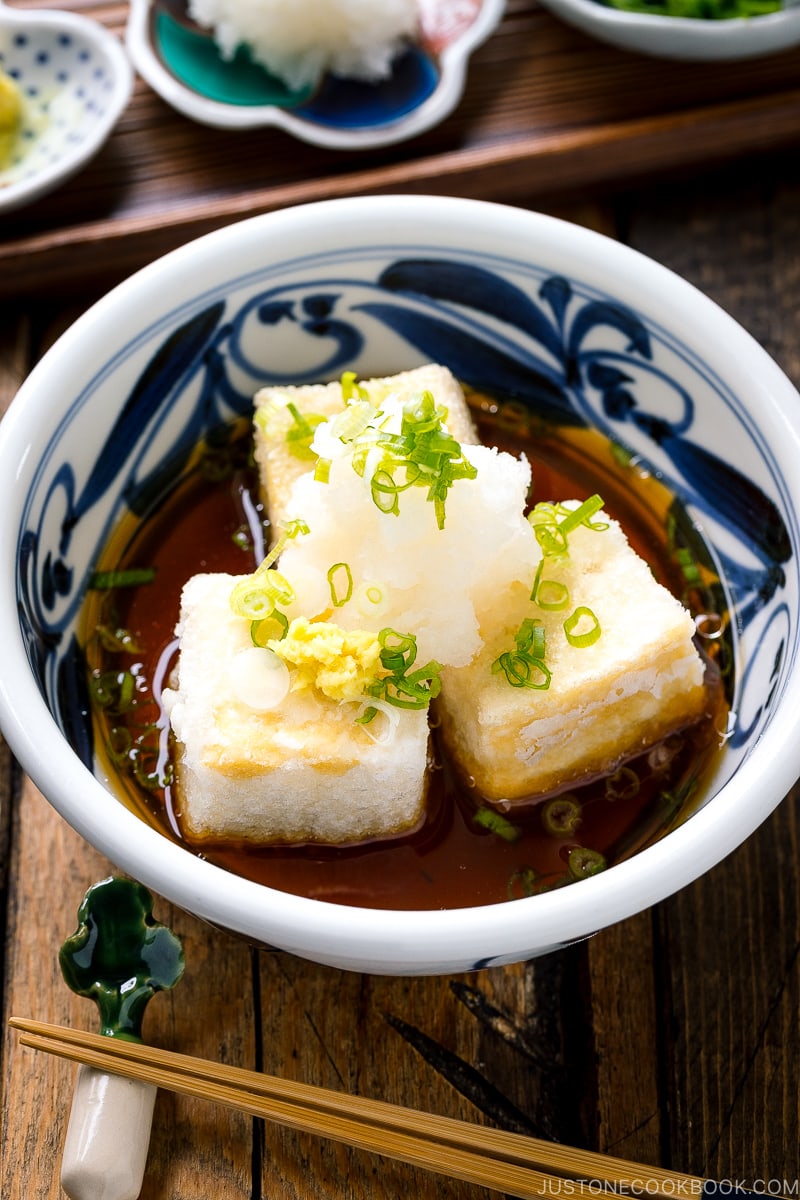
What is your favorite appetizer when you dine at a Japanese restaurant? Many JOC readers told me that they love ordering Agedashi Tofu (揚げ出し豆腐). Served in a sweet-savory broth, these lightly fried crispy tofu have an airy crunch and melt-in-your-mouth texture. So good that you wish you could eat the entire bowl yourself!
Agedashi tofu is actually not difficult to make if you don’t mind frying. I’ll show you a foolproof method on how to make this popular Japanese appetizer at home!
Table of contents
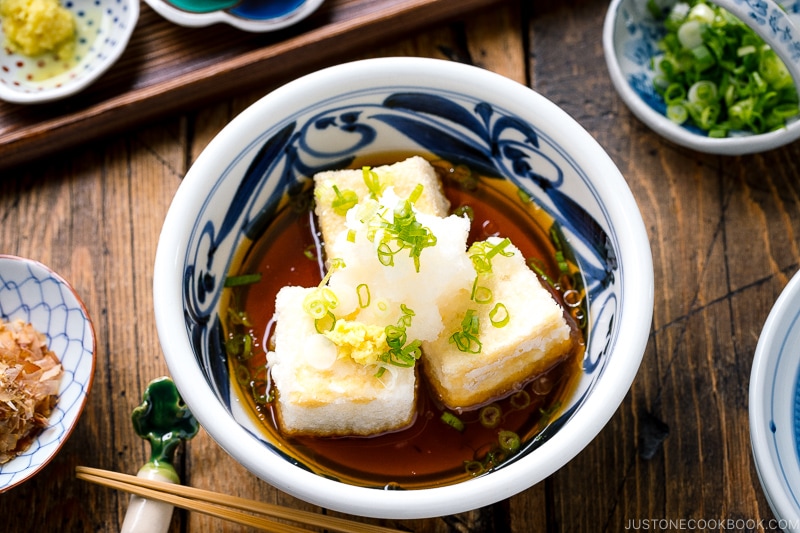
What is Agedashi Tofu?
Agedashi tofu, or what we call agedashi dofu (揚げ出し豆腐) in Japan, is made of soft or medium-firm tofu coated with potato starch and deep-fried so that the outer shell is crispy and the inside is smooth and custardy.
Right before serving, a warm tsuyu (sauce) is poured over the tofu to render an irresistibly umami flavor with a touch of sweetness. It is then garnished with a variety of toppings such as grated daikon, katsuobushi (bonito flakes), scallion, and grated ginger. For a spicy kick, you can sprinkle it with a light dusting of shichimi togarashi.
Served piping hot, agedashi tofu is arguably one of the most amazing tofu dishes one can ever have!
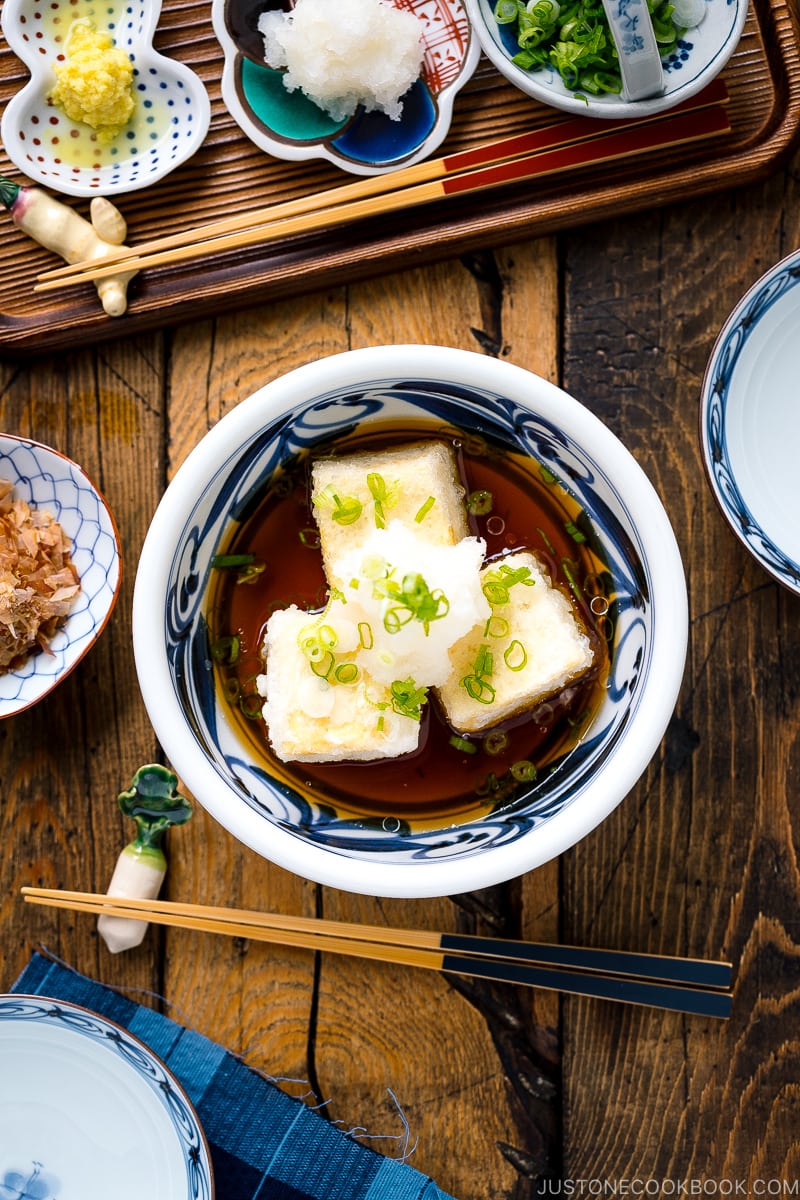
How to Make Agedashi Tofu
Ingredients You’ll Need
- Medium-firm tofu (momen dofu) or soft tofu (kinugoshi dofu) – If you’re new to making this dish, start with medium-firm tofu as it’s easier to handle.
- Potato starch – Please try getting potato starch instead of cornstarch (read more below).
- Cooking oil for deep-frying or shallow-frying.
- Tsuyu sauce: dashi (or use vegan-friendly kombu dashi), mirin, and soy sauce.
- Garnish: daikon radish, green onion, ginger, and katsuobushi (dried bonito flakes).
Overview: Cooking Steps
- Drain the tofu for 15 minutes. Don’t drain too long if you want the soft velvety texture on the inside.
- Meanwhile, make tsuyu sauce by combining dashi, mirin, and soy sauce.
- Cut the tofu block into 6 pieces (roughly 1.5-2 inch cubes) and coat them with potato starch.
- Deep fry the tofu for 2 minutes until lightly browned and drain the excess oil.
- Serve the tofu in a bowl and pour the tsuyu sauce. Garnish the tofu with grated daikon, chopped green onion, grated ginger, and bonito flakes.
How to Press Tofu
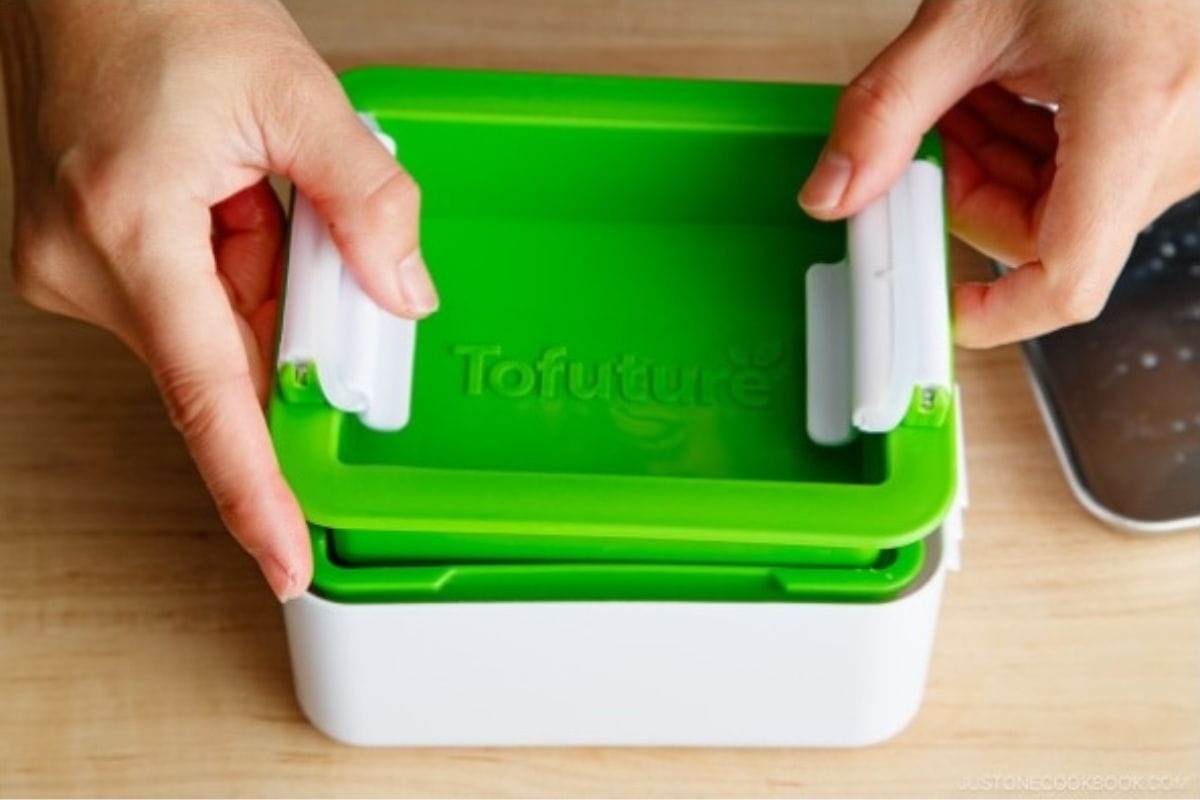
As you know, you can press tofu with a heavy object like a pot filled with water. However, I wanted to speed up the pressing time and make it more compact when doing this process, so I tried Tofuture Tofu Press and I wish I had gotten it sooner. It’s one of the best tofu presses because it’s easy to use and doesn’t take up much space.
Now, I don’t have to risk a heavy object falling while pressing my tofu and it takes up much less of my prep space. It drains tofu quickly, and you’ll only have to press it for about 15 minutes to make Agedashi Tofu. If you have been debating getting a tofu press, don’t wait—just get this one on Amazon for $22!
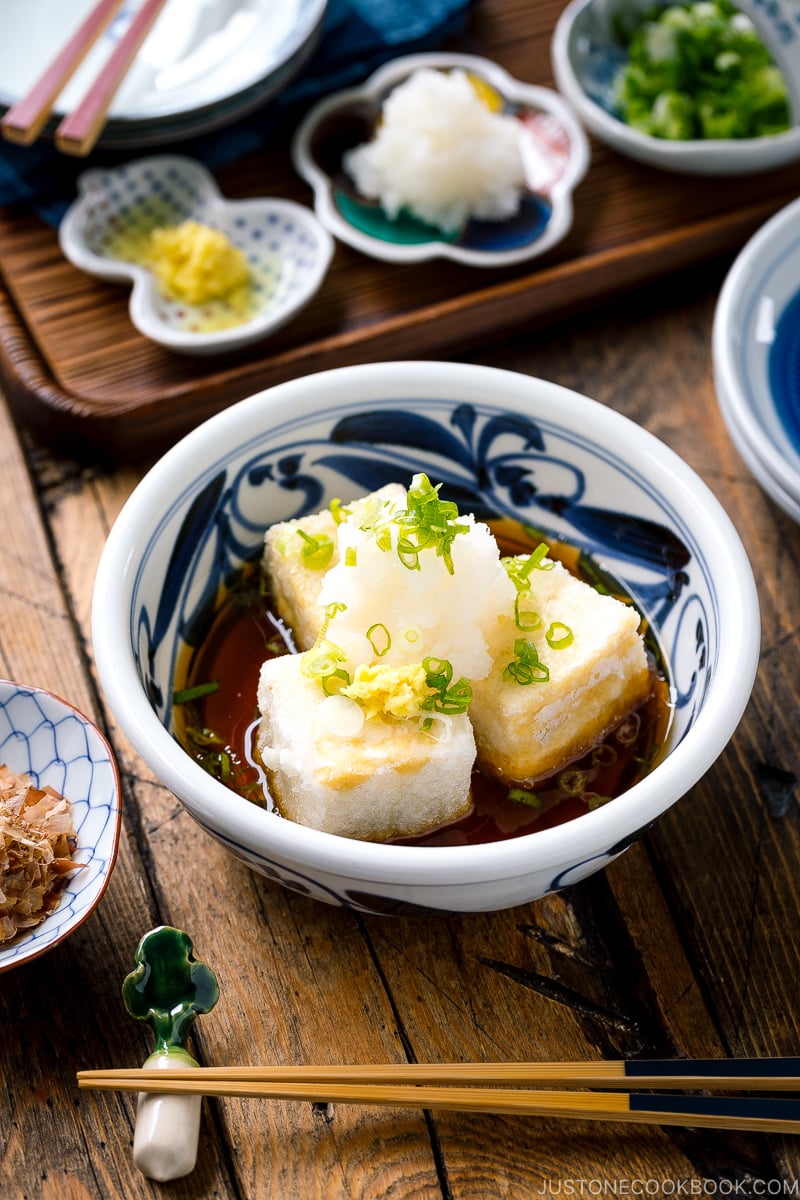
Know the Differences: Potato Starch vs. Cornstarch
In Japan, agedashi tofu is always made with potato starch or katakuriko (片栗粉).
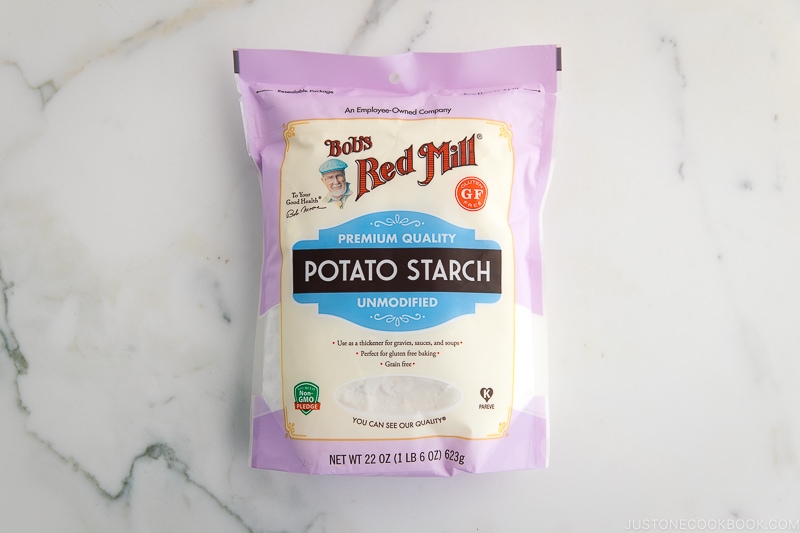
I’ve tried making agedashi tofu with cornstarch before and you definitely can use cornstarch. However, the texture is slightly different and a JOC reader once said it was very difficult to deep fry the tofu coated with cornstarch. Since cornstarch particles are much finer than potato starch, the coating just disappears as soon as the tofu is added to the deep-frying oil.
Another bonus is when we use potato starch to thicken the sauce, the color of the sauce doesn’t get altered by the potato starch as opposed to cornstarch that tends to leave its whitish crumbs.
So… it’s up to you. I buy potato starch from Bob’s Red Mill or a Japanese brand of potato starch from Japanese/Asian grocery stores
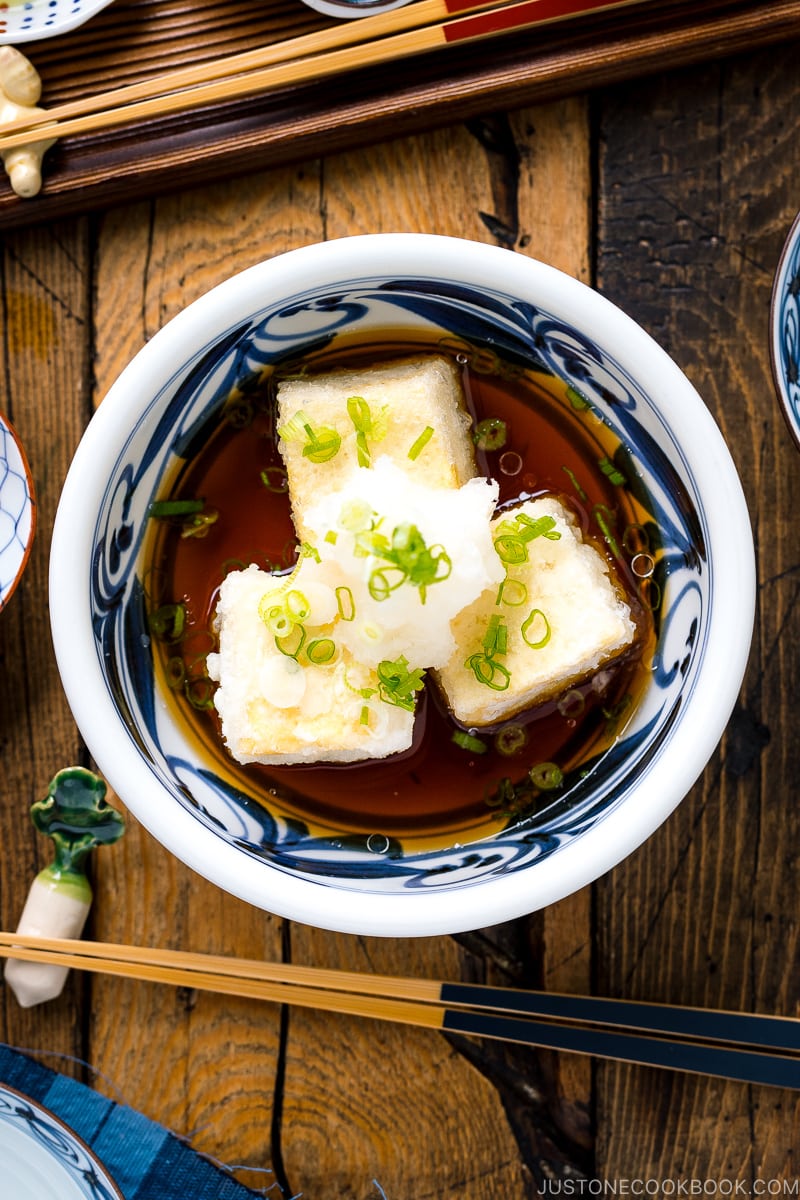
5 Important Cooking Tips
- Drain medium-firm tofu for 15 minutes, not too long, if you want a tender, soft tofu texture on the inside.
- Use potato starch if you really want to achieve the best texture.
- Coat the tofu with potato starch right before deep-frying. Don’t let it sit after you apply potato starch as the moisture coming out from the tofu will make the coating soggy and the crust may come off.
- Deep-fry at a lower temperature, about 320-340ºF (160-170ºC) degrees. Tofu contains a lot of moisture; therefore; it’s not recommended to deep-fry at high temperatures.
- Deep-fry in batches, so the tofu pieces don’t stick to each other.
Topping Choices for Agedashi Tofu
You can pick your favorites from the list below. Either prepare all of them or make it a fun topping bar.
- Grated daikon
- Chopped green onions/scallions
- Grated ginger
- Katsuobushi (dried bonito flakes)
- Shredded nori seaweed (kizami nori)
- Shichimi Togarashi (Japanese seven spice)
- Deep-fried lotus root chips
- Deep-fried shishito peppers
- Deep-fried eggplant (similar cooking method as this recipe)
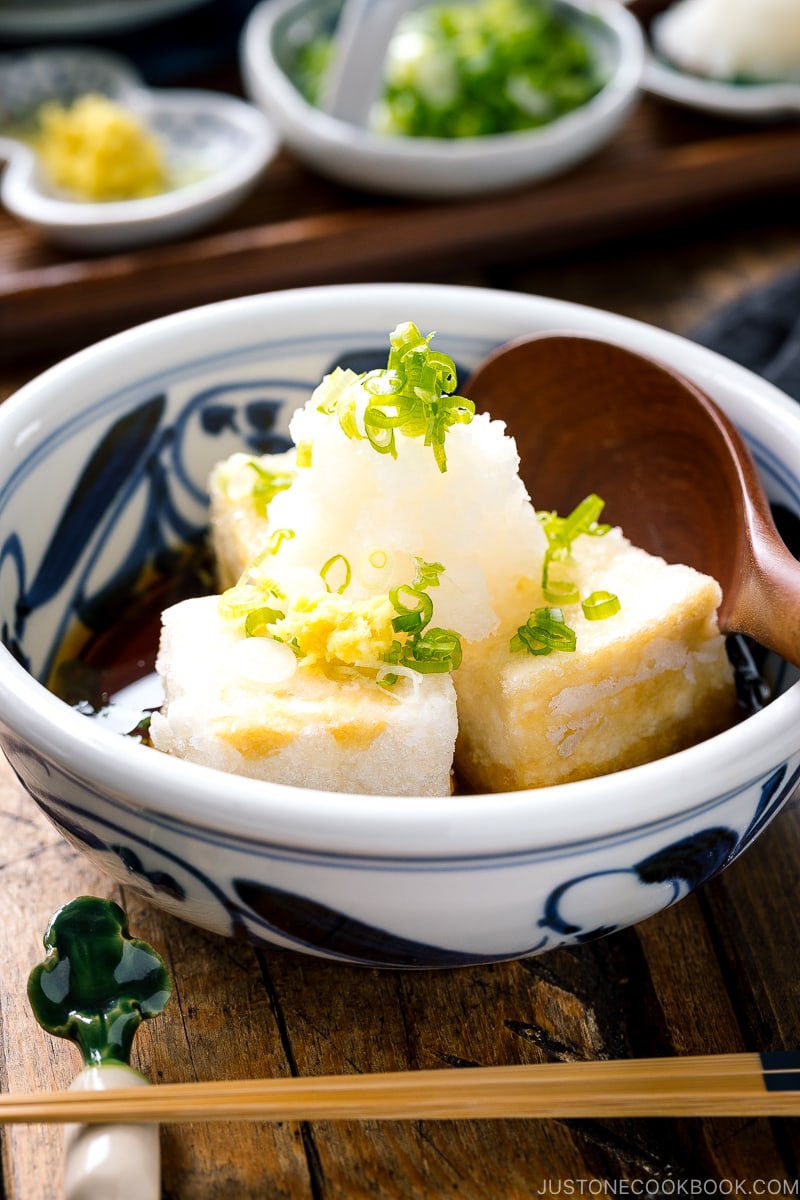
How to Make It Vegan
You can easily make it vegan:
- Use kombu dashi.
- Skip katsuobushi (dried bonito flakes) and substitute it with shredded nori for topping
If you enjoy making my agedashi tofu recipe at home, give us a rating or leave a comment to share your experience below!
More Popular Tofu Recipes on JOC
- Mapo Tofu
- Pan-Fried Teriyaki Tofu Bowl
- Green Bean Shiraae (Mashed Tofu Salad)
- Creamy Miso Pasta with Tofu and Asparagus
- Tofu Pizza
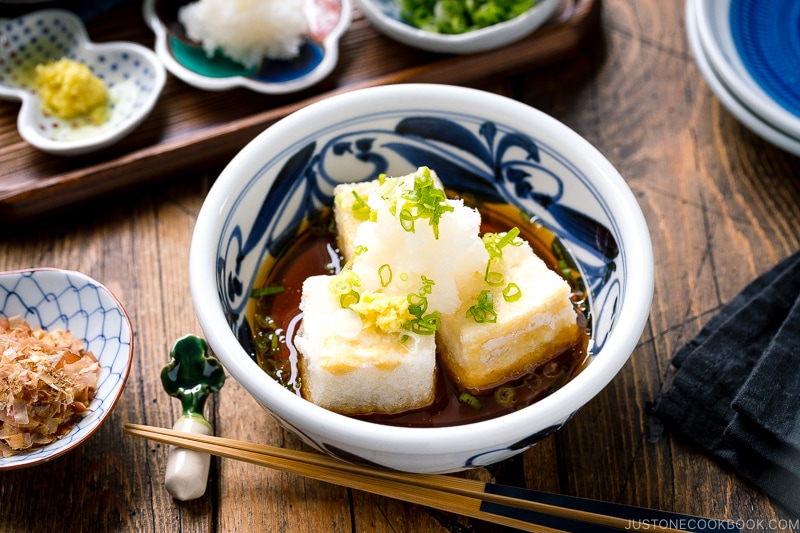
Wish to learn more about Japanese cooking? Sign up for our free newsletter to receive cooking tips & recipe updates! And stay in touch with me on Facebook, Pinterest, YouTube, and Instagram.
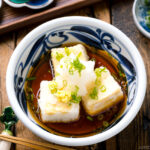
Agedashi Tofu
Video
Ingredients
- 1 block medium-firm tofu (momen dofu) (14 oz, 397 g; or use silken tofu)
For the Toppings
- 2 green onions/scallions
- 2 inches daikon radish
- 1 tsp ginger (grated)
For the Sauce (“Tsuyu“)
- 1 cup dashi (Japanese soup stock) (use standard Awase Dashi, dashi packet or powder, or Vegan Dashi)
- 2 Tbsp soy sauce
- 2 Tbsp mirin
For Deep-Frying
- 2 cups neutral oil (enough for 1 inch (2.5 cm) of oil in the pot)
- 4 Tbsp potato starch or cornstarch
For the Garnish
- 1 package katsuobushi (dried bonito flakes) (optional; skip for vegetarian)
- shichimi togarashi (Japanese seven spice) (optional, for a spicy kick)
Instructions
- Gather all the ingredients. If this is your first time making this dish, use medium-firm tofu instead of the soft silken variety since it‘s easier to cook without breaking. If you prefer a silky texture, give silken tofu a try once you‘re more comfortable making Agedashi Tofu.
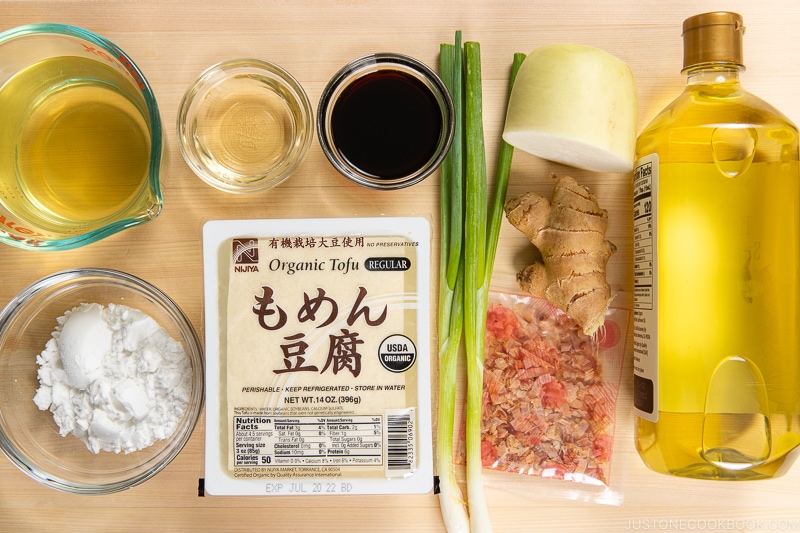
- Place 1 block medium-firm tofu (momen dofu) on a tray or plate. Wrap the tofu in 2–3 layers of paper towels and place another tray on top. Set a heavy object on top to press the tofu. Drain the water out of the tofu for 15 minutes.
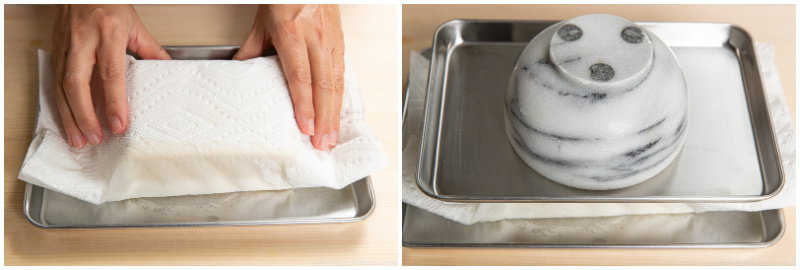
To Prepare the Toppings
- Cut 2 green onions/scallions into thin slices. Set aside.
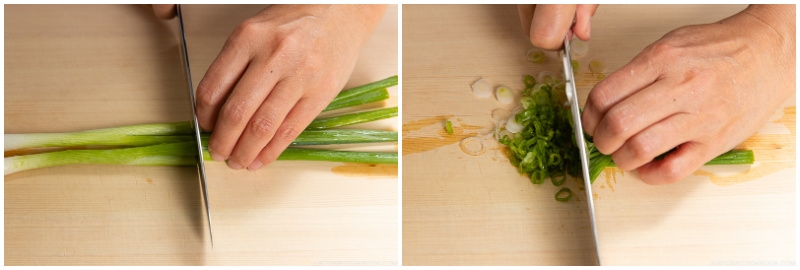
- Peel and grate 2 inches daikon radish (I use a ceramic grater).
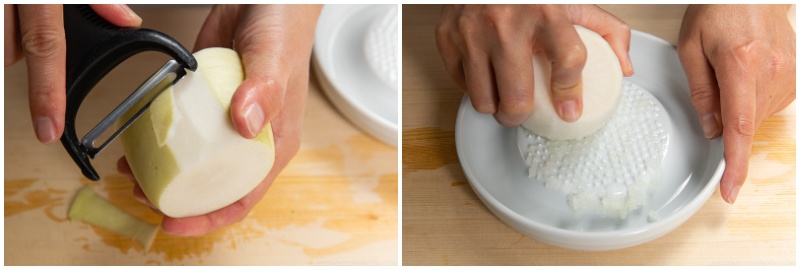
- Gently squeeze most of the water out of the grated daikon, keeping some moisture. Set aside.
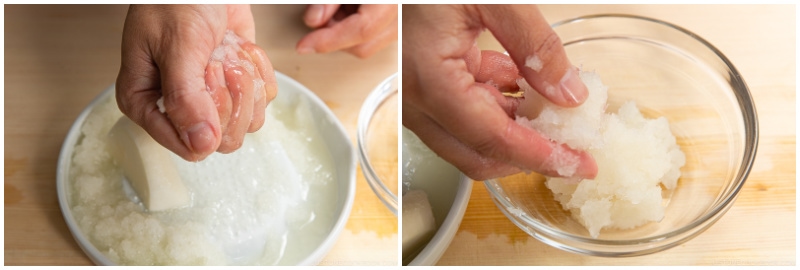
- Peel and grate the ginger. You will have roughly 1 tsp ginger (grated, with juice). Set aside.
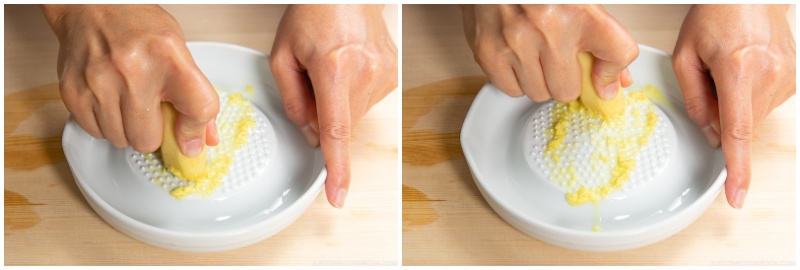
To Make the Sauce (“Tsuyu“)
- Add 1 cup dashi (Japanese soup stock), 2 Tbsp soy sauce, and 2 Tbsp mirin to a small saucepan.
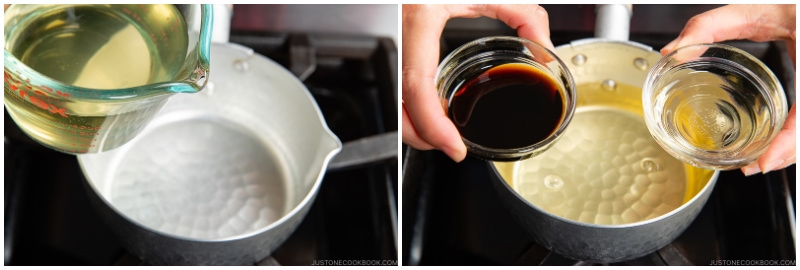
- Bring to a simmer. Then, turn off the heat, cover with a lid, and set aside.
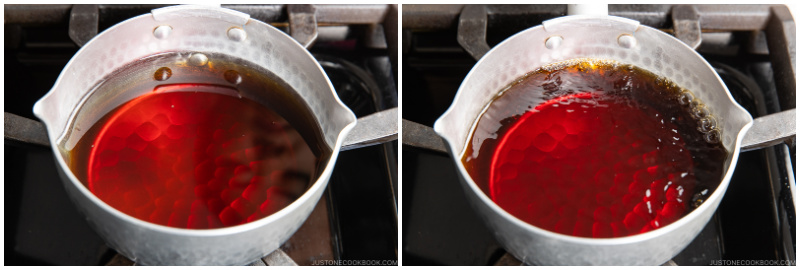
To Deep-Fry
- Heat 2 cups neutral oil to 320–340ºF (160–170ºC) degrees in a deep fryer or medium pot. Make sure there‘s about 1 inch, 2.5 cm of oil in the pot. Remove the paper towels from the tofu.
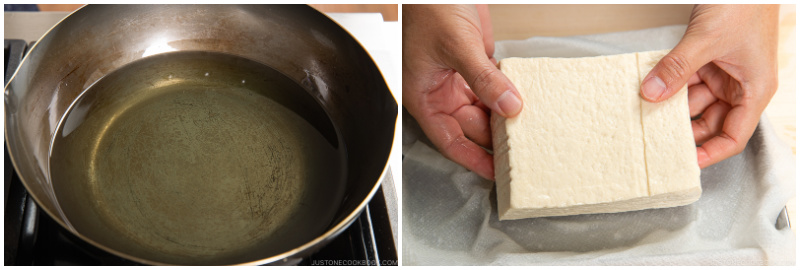
- Cut the 1 tofu block into 6 pieces.
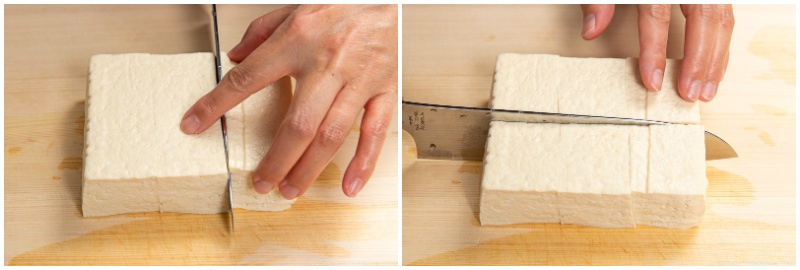
- Coat the tofu pieces with 4 Tbsp potato starch or cornstarch, dusting off any excess.
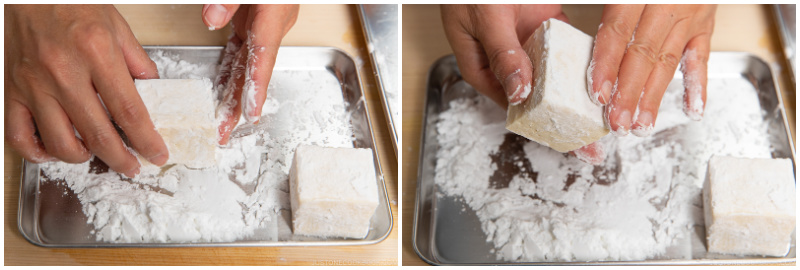
- When the oil is hot, add the tofu pieces in batches. Here, I add 3 pieces at a time. Be careful not to overcrowd the pan or the oil temperature will drop. Deep-fry, turning once, until they are light brown and crispy.
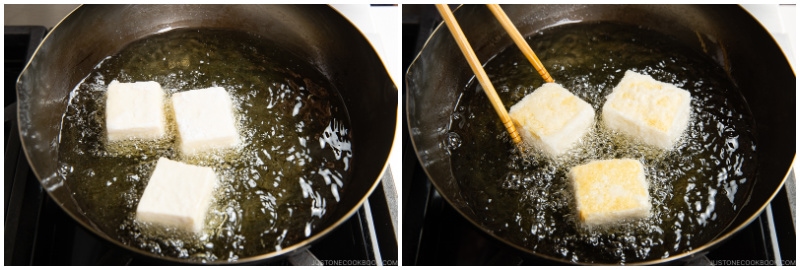
- Remove the fried tofu pieces from the oil and place them on a wire rack or a plate lined with paper towels to drain the excess oil. Continue to deep-fry the remaining tofu pieces. Then, place the fried tofu in individual serving bowls.
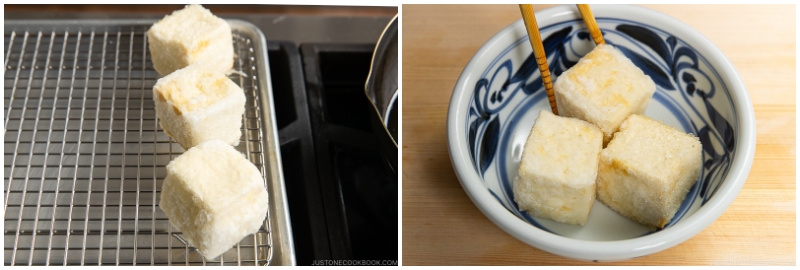
To Serve
- To serve the Agedashi Tofu, gently pour in the sauce at the edge of each bowl without wetting the top of the fried tofu. Top with some grated daikon, grated ginger, and green onion slices. For optional garnishes, sprinkle with 1 package katsuobushi (dried bonito flakes) and shichimi togarashi (Japanese seven spice).
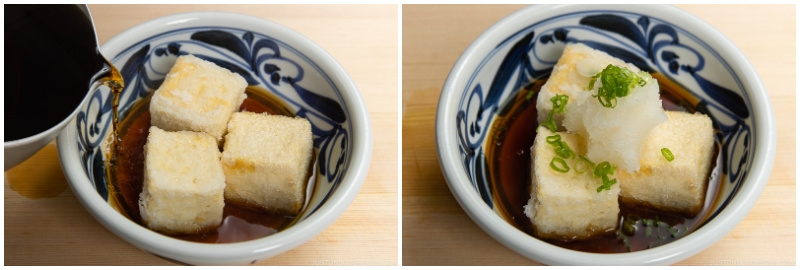
To Store
- You can keep the leftover sauce and fried tofu separately in airtight containers and store in the refrigerator for 3 days.
Nutrition
Editor’s Note: This post was originally published on June 13, 2011. A video and updated images were added on April 30, 2014. The post has been updated with new images and content on June 28, 2022.
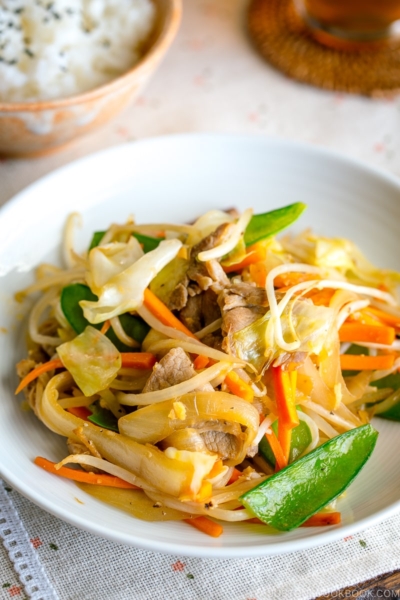
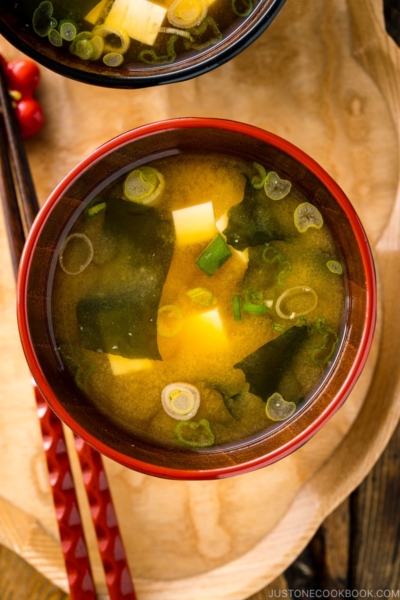
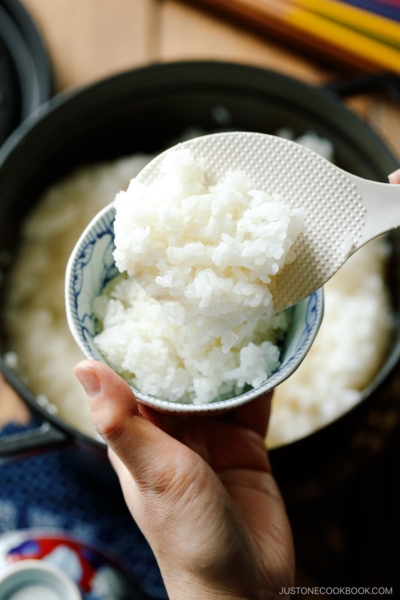
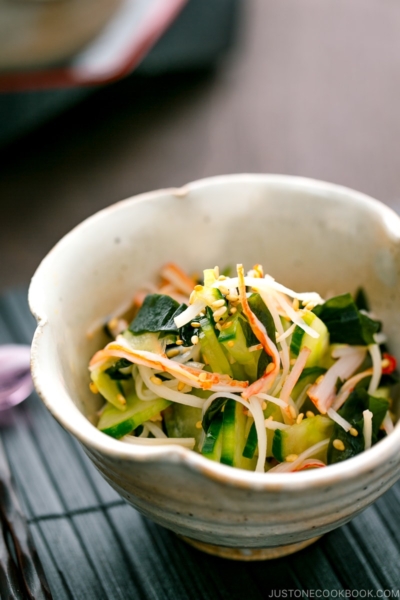




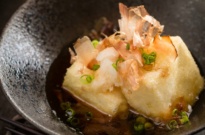
I suggested this dish to a friend who asked what she could use tofu for and I wanted to make it for her as she’s clueless about japanese food and thought it might be nice to expose her to the cuisine. What should I serve it with other than rice? I was thinking of a broccoli stems gomae (for nutty/fresh/crunch), possibly sauteed shiitake & cut up nori (for umami & color) and some Shibazuke pickles (for sweet/sour/crunch) – plus some genmai to drink. Anything else or will those things make a good combo of sweet/sour/salty/umami/bitter?
thanks!
Hi Jules! I am so sorry I couldn’t get back sooner. I had been sick for 2+ weeks and I’m finally back!
You’re such a sweet friend! Your menu sounds excellent! If you or she is vegan/vegetarian (since no meat mention), I would suggest following (but just optional since you asked):
https://www.justonecookbook.com/vegan-miso-soup/
https://www.justonecookbook.com/warm-mushroom-salad-sesame-dressing/
https://www.justonecookbook.com/miso-dengaku/
https://www.justonecookbook.com/eggplant-agebitashi/
Can the sauce be used for anything else?
You can make similar food with different ingredients, such as deep fry eggplant, etc. 🙂
Amazing! The tofu and the sauce turned out surprisingly well. Even my partner was surprised at how similarly it all compared to a Japanese restaurant. The only problem was when I finally put it all together, the potato starch coating got very soggy and gummy. Not really sure how to avoid this issue, any suggestions?
Hi Tress! I’m glad to hear your tofu and sauce came out well. Was it possible that tofu was coated with too much potato starch? Also was the deep fried temperature correct? Another thing is to make sure to add the tofu (coated with potato starch) right away without leaving the starch on tofu. It gets moisture and the coating gets wet. You have to put inside the oil right away. 🙂 Hope that helps!
Another win at our house. I was reminded of agedashi tofu when going out for sushi with a colleague yesterday. I was instantly brought back to being a young adult in San Francisco having it for the first time in a Japantown restaurant after bowling with friends.
I looked for a recipe to make at home and found it here with you Nami! It tastes JUST LIKE it did at the restaurant. Thanks again for the good food!
Hi Gail! That’s so cool! I’m really happy to hear yours came out well! Thank you so much for trying my recipe! Isn’t it nice to be able to cook it at home with much less cost and any time! 😀
Hi Nami! Nikki J. from Idaho here.
I’m pressing my tofu dry as I type this. I can’t wait to finish this dish! I’m using peanut oil since that’s all I have. Is that going to change the taste at all? Better or worse? I like using peanut oil to fry in (fried chicken, tonkatsu, tempura, etc…). I like the taste with breaded items but I’ve never used it with tofu.
Advice? Sounds good? Idk…🤨😏😊
UPDATE:
Okay, this is INSANELY delicious!!! The peanut oil worked fine and each tofu cube fried up crispy and light golden. I used a good thermometer to ensure temperature and timing was good. Now, don’t yell but I did add a teaspoon of sugar to the dashi broth since the hubby wasn’t in the mood for uber savory fishiness. Even so, the rest was completely yours. I’ve been fearful of deep frying due to an unfortunate accident 3 years ago but I’ve been much more careful since starting my Japanese cooking journey. Thank you SO much for the amazing recipes and wonderful YouTube tutorials – they are honestly the best I have found. Luv ya’ Nami!!! <3 <3 <3
Hi Nikki! Happy to hear from you! (And apology for not being able to respond sooner to your previous comment)
I’m so glad your Agedashi Tofu came out well and yes, peanut oil is fine. Agedashi tofu broth can be sweeter – some places give sweeter taste some places more savory side. Feel free to adjust. I tend to go on sweeter side more on my recipes, and I have some readers who raise eyebrow on how much sugar is added to some of my recipes… haha. Well, Japanese cooking requires sugar because it includes salty condiments like soy sauce and miso. You can’t avoid sugar to balance out the flavor…. anyway, feel free to adjust to your liking. 🙂
I’m glad you are (almost?) over your fear of deep frying. I had some accident before too (I still have burnt scars from hot oil on my cheek bone (that do not go away!). I try to be more careful since. I love deep frying at home (better oil) and haven’t stopped. 😀
Happy cooking! Thank you for leaving the feedback all the time. xo
Thank you for the reply Nami.
Oh, good. I was hoping I wasn’t ruining the dish! My deep frying accident left scars on my stomach. (yikes.) I was being irresponsible and had on a long, wide sleeved blouse and the cuff caught the handle on the pot. The rest is kind of gross. Any-whoo, now I keep the pot at the back of the stove and wear short sleeves when I deep fry!
Nami, I love your recipes and ongoing communication with you. It makes me feel sort of special. (Lol!) You possess such an easygoing mannerism and are so pleasant to watch and listen to. When I first came across your videos and online recipes, I was taken aback by the ease of understanding and the gentle tone of your voice. Those attributes made it so easy to become a devoted fan. I must tell you though, I have been enamored by all things Japan since I was a very small girl. My family was very old fashioned, middle America country folk who primarily cooked and ate biscuits and gravy, chicken fried steak, apple pie and beer……lots of beer. None of this appealed to to me and it all made me sick. I had a friend in grammar school who’s family was from Kyoto and invited me to her house for dinner. The meal was the best one I had ever had (did not make me sick!), not to mention the decor of the house made me feel so peaceful and homesick for somewhere I had never been. I was only 9 years old but I began reading everything I could on Japanese culture, history, lifestyle and more. The langauge was not offered in any schools I attended and of course there was no internet back then so I had to settle for food and books. Kimi’s family provided all kinds of information for me but her father would never talk about the war or the Japanese military which sadly my grandfather was all too opinionated on. (Not in a good way either.) So, when I became an adult and could do what I wanted I continued to learn. Kimi and her family moved out of state and I lost my closest friend and source of info. So, I’ve had to educate myself further and would give anything to be able to afford a trip to Japan. I utilize an online course in Japanese currently and am currently studying Hiragana, Katakana and Kanji – the introduction to the basics. Being so remote here in Idaho, college campuses are a great distance to travel. But as far as the food goes, I have you! I know you will keep my belly full and my mind inspired. Thank you.
Hi Nikki! I am sorry for my late response. Oh no, your injury seems a lot scarier and I’m sorry that happened to you. I’m glad you are taking precautions now.
Aw thank you for your kind words. I’m happy I could interact with nice people around the world like you, learning about foods and culture, and they inspire me to work harder to share my recipes and culture.
Your story about your childhood was very interesting and it’s really interesting you got to meet Kimi and you continue to learn about Japanese culture (and there was no internet back then, so without her, it must have been hard to collect information). I hope you will get to visit Japan one day, and it’s really cool that you’re learning the language! 日本語がんばってください! :)
Really great photos and instructions, thank you! I’ve made the agedashi tofu before but needed helped with the broth and how to arrange toppings and all of this was perfect to follow. Thanks!
Hi Lauren! Thank you so much for your kind feedback. I’m happy to hear you like how I write instructions with images. 🙂 Enjoy!
You can actually find potato starch in the grocery stores here (usually in the health food section of your grocer has one) or on amazon.com. Bob’s Red Mill is the most common brand, and it works well.
I use it frequently in gluten free cookery and baking.
Hi Michelle! Thanks for your tip on the health food section of the grocery store. Yes, Bob’s Red Mill is wonderful!
Dear Nami,
Thank you for sharing all these amazing recipes which I cook almost daily! I love Japanese food.
I’m also a vegetarian and I’m able recreate almost any recipe by using vegetables.
I wanted to share with you a ‘discovery’ I made yesterday trying to recreate the delicious smokey flavour of katsuoboshi especially for making Dashi.
So, I have started using 1 black cardamom pod in the konbu Dashi and the result is incredible. Black cardamom is a spice used in Vietnamese and Indian cooking. If you get to try it, I’d love to hear what you think. I really loved the agedashi tofu made vegetarian with the use of this pod ????
Anyway, have a great week. Arigatou!
Hi Dany! Thank you for trying my recipes (almost daily)! I’m happy to hear you enjoy Japanese food. 🙂 . Wow how interesting! Thanks for sharing your discovery. Black cardamom pod! I would never think of adding that in, so that is an interesting find indeed! I use green one for making chai. I would love to try black cardamom in dashi next time!
I made this tonight. I used sweet potato starch on half and tapioca starch on the other half. Tapioca flour came out crispy, but once the sauce touched it the crispy outside became a gelatinous goop. The sweet potato starch was crispy and softens after the sauce was put on top but did not get goopy like tapioca. Thanks Nami! This was delicious! I cannot find a place in my town that makes decent Agedashi Tofu and I cannot get to Gombei in San Jose as often as I would like (I love their version).
Hi Annie! Thank you for trying this recipe, and with both flours! Thanks for your feedback on tapioca starch. Some readers asked me about tapioca starch, but I’ve never used it before. Some says it’s same, but I see that the texture is different. Good to know! Thanks for your kind feedback. I’ve never tried Gombei before. I’ll remember for next time!
I LOVE this recipe! But I wonder if I am doing something wrong – I use potato starch and soft tofu and the flavor is incredible but the coating gets like glue and sticks to whatever it touches. Is there some way around this? Maybe I’m not frying it long enough?
Hi Julie! When does the coating gets like glue and sticks to whatever it touches? Is it after serving, or while deep frying?
Was it nice and firm after you deep fried? Like crispy tofu?
I understand it gets jelly-like texture IF the tofu is soaked in dashi for a long time. The coating is from potato starch so it just absorbs liquid and gets jelly-like.
But it will take a long time sitting in the dashi to become like that.
Maybe you put too much potato starch? Maybe your oil wasn’t hot enough?
Thank you so much for sharing this recipe. This is one of my favorite things to order from Japanese restaurants but it is somewhat expensive. I can’t wait to make this at home!
Hi Christine! I agree, it’s quite expensive for… tofu dish! I hope you enjoy making this recipe at home. 🙂
This recipe is excellent! I’ve had agedashi tofu in countless Japanese restaurants and this rivals them all. And, who knew it was so simple to make?! Thanks for another great glimpse into creating fantastic Japanese cuisine. (Your nama chocolate is another great one.)
Hi JR! I’m so happy to hear you tried this recipe and liked it! Yeah a lot of Japanese foods are pretty simple to make. 🙂 I’m glad you like nama chocolate too! Thank you for your kind feedback!
Thank you for the recipe! I tried it today and I expected it to be crispy but all the skin stuck together after I poured the sauce on. Is this what its supposed to be like?
Hi Hannah! All the skin stuck to… where? The potato starch coating is supposed to be stuck to tofu, but maybe you mean something else? Or do you mean stuck to each other?
Any recomended usage for the leftover oil? Thanks
Hi Lu! I usually do some deep frying recipes (tempura, tonkatsu, all kinds of deep fried dishes!) after IF the oil looks still clean (not dark or too many bubbles).
Otherwise I’ll toss away using this Japanese powder (shown in the picture here: https://www.justonecookbook.com/how_to/how-to-deep-fry-food/) or put in a glass jar and throw away (please follow your city’s rule to throw away cooking oil).
Hope this helps!
Thanks
Try it just once – you’ll be surprised that it really doesn’t taste like tofu. I was certainly amazed and it’s a favourite dish now! 🙂
Comfort food. Mmmmm!